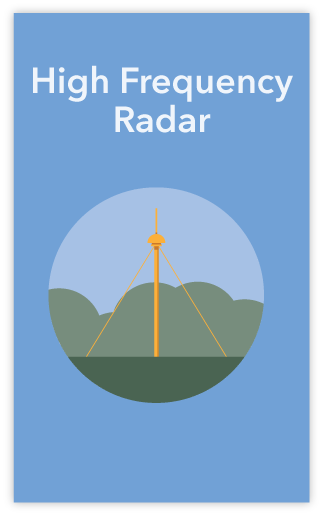 High-frequency radar (HF Radar) is a unique technology mapping ocean surface currents and wave fields (along with other variables) over wide areas with high spatial and temporal resolution. HF Radar is cost-effective, requiring only small manpower and technical costs.
High-frequency radar (HF Radar) is a unique technology mapping ocean surface currents and wave fields (along with other variables) over wide areas with high spatial and temporal resolution. HF Radar is cost-effective, requiring only small manpower and technical costs.
Users of HF Radar technology include meteorology services, search and rescue agencies, governments and regional and local authorities, as well as private companies working in assessment of coastal water quality, renewable energy, or other environmental services.
The EuroGOOS HF Radar Task Team helps coordinate the European activities around the development and use of this coastal technology. The Task Team is providing a European HF Radar operational network delivering data and products for science, environmental management, and operational needs. As all EuroGOOS operational task teams, the HF Radar Task Team plays an important role in identifying research gaps, delivering common standards and promoting synergy, towards an integrated European Ocean Observing System (EOOS).
The EuroGOOS HF Radar Task Team contributes to improving administrative procedures, promotes scientific synergies and complementarity with other technologies as well as modeling products. The Task Team’s broad network allows sharing success stories and discuss common challenges, to allow a stronger joint progress.
Specifically, the HF Radar Task Team aims to:
- Define data standards and products;
- Define and share the quality assurance and quality control standards;
- Promote research, technology and innovation development;
- Enhance interface between the technology providers and implementers.
The EuroGOOS HFR Task Team is coordinating the European High Frequency Radar Node (HFR Node) as the focal point and operational asset in Europe for HFR data management and dissemination, also promoting networking between EU infrastructures and the Global HFR network.
List of Members
Co-chair
- Julien Mader, AZTI, Spain
- Lorenzo Corgnati, CNR ISMAR, Italy
Members
- Adam Gauci, University of Malta, Malta
- Alejandro Gallego, Barbara Berx, Bill Turrell, Marine Scotland Science, United Kingdom
- Ana Konstantinidou, Gerasimos Korres, HCMR, Greece
- Anna Rubio, Lohitzune Solabarrieta, AZTI, Spain
- Andres Alonso Martirena, Ismael Lopez, Maria Fernandes, Alkiviadis Kalampokis, Qualitas Remos, Spain
- Anne-Claire Bennis, University of Caen, France
- Anne-Marie Fitzgerald, Joanne Cullinane, Rosemary Lawlor, Met Éireann, Ireland
- Antonio Novellino, ETT, Italy
- Arianna Orasi, Matteo Marasco, Italian National Institute for Environmental Protection and Research (ISPRA), Italy
- Bernardo Gozzini, Stefano Taddei, Consorzio LaMMA, Italy
- Branko Cermelj, Matjaz Licer, Vlado Malacic, National Institute of Biology, Slovenia
- Bruno Zakardjian, Céline Quentin, Charles-Antoine Guérin, MIO – Univ. of Toulon, France
- Bruce Hackett, Sune Jensen, Kai Christensen, Kjetil Stiansen, Snorre Ronning, Vegar Kristiansen, Terje Borge, Norwegian Meteorological Institute, Norway
- Cariou Valérie, Franck Dumas, Stéphanie Louazel, SHOM, France
- Carlo Mantovani, Annalisa Griffa, Carlo Brandini, Bartolomeo Doronzo, CNR-ISMAR, Italy
- Carlos Barrera, Ruben Marrero, Joaquin Brito, PLOCAN, Spain
- Concepción Bueno, Generalitat de Catalunya, Spain
- Cristina González-Haro, Emili García-Ladona, Joaquim Ballabrea-Poy, Justino Martínez, Lucía Quirós-Collazos, Jordi Isern-Fontanet, Institut de Ciències del Mar (CSIC), Spain
- Daniel Conley, University of Plymouth, United Kingdom
- Emma Reyes, Guiomar López, Joaquin Tintoré, SOCIB, Spain
- Enrico Zambianchi, University of Rome La Sapienza, Italy
- Fulvio Capodici, Giuseppe Ciraolo, University of Palermo, Italy
- Garbiñe Ayensa, Pedro Montero, Intecmar, Spain
- Gisbert Breitbach, Jochen Horstmann, Johannes Schulz-Stellenfleth, Marius Cysewski, Helmholtz-Zentrum Geesthacht, Germany
- Guillaume Charria, Louis Marié, Ifremer, France
- Hezi Gildor, Institute of Earth Sciences, Israel
- José Gonzalez Fernandez, Ramiro Varela, University of Vigo, Spain
- Lucy Wyatt, Seaview Sensing, UK
- Pablo Lorente, Puertos del Estado, Spain
- Patrick Gorringe, SMHI, Sweden
- Pierpaolo Falco, Università Politecnica delle Marche, Italy
- Roberto Gomez, HELZEL Messtechnik, Germany
- Roberto Pinna Nossai, Giovanni Ficca, ARPA Sardegna, Italy
- Silvia Piedracoba Varela, CETMAR, Spain
- Stipe Muslim, Vlado Dadic, Institute of Oceanography and Fisheries, Croatia
- Vanessa Cardin, Laura Ursella, OGS, Italy
- Vânia Lima, Instituto Hidrografico, Portugal
- Vassilis Zervakis, University of the Aegean, Greece
EuroGOOS Facilitation:
- Deniz Karaca, Science Officer
Terms of Reference
|
High Frequency Radar ToR |
348.21 KB |
Group technical documents (Scientific papers, project deliverables, etc), follow this LINK
HF Radar map (Click on the stations dots for more information)
Map of locations of the 107 HFRs included in the current EuroGOOS Task Team inventory (July 2021). The ongoing systems (69) are plotted in green, future installations (14) in yellow and non-functioning (24) in purple (including historical deployments or currently inactive stations). 45 HFRs are connected to the HFR node (pulsing circles) sending data in near real-time.















































